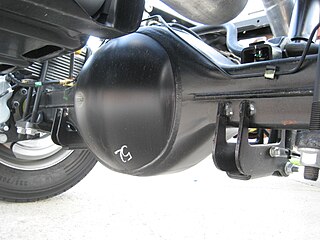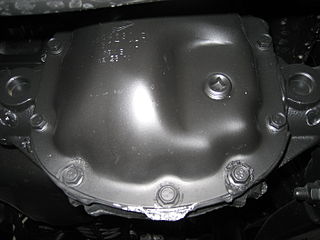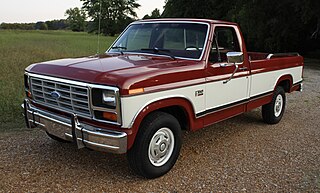
An axle or axletree is a central shaft for a rotating wheel or gear. On wheeled vehicles, the axle may be fixed to the wheels, rotating with them, or fixed to the vehicle, with the wheels rotating around the axle. In the former case, bearings or bushings are provided at the mounting points where the axle is supported. In the latter case, a bearing or bushing sits inside a central hole in the wheel to allow the wheel or gear to rotate around the axle. Sometimes, especially on bicycles, the latter type of axle is referred to as a spindle.

A limited-slip differential (LSD) is a type of differential gear train that allows its two output shafts to rotate at different speeds but limits the maximum difference between the two shafts. Limited-slip differentials are often known by the generic trademark Positraction, a brand name owned by General Motors and originally used for its Chevrolet branded vehicles.

The Ford Bronco is a model line of SUVs manufactured and marketed by Ford. The first SUV model developed by the company, five generations of the Bronco were sold from the 1966 to 1996 model years. A sixth generation of the model line was introduced for the 2021 model year. The nameplate has been used on other Ford SUVs, namely the 1984–1990 Bronco II compact SUV and the 2021 Bronco Sport compact crossover.

The Ford Super Duty is a series of heavy-duty pickup trucks produced by the Ford Motor Company since the 1999 model year. Slotted above the consumer-oriented Ford F-150, the Super Duty trucks are an expansion of the Ford F-Series range, from F-250 to the F-600. The F-250 through F-450 are offered as pickup trucks, while the F-350 through F-600 are offered as chassis cabs.
The TREMEC TR-4050 is a 5-speed manual transmission for longitudinal engine rear wheel drive trucks. It includes one overdrive gear and a light-weight aluminum housing. It is manufactured by Transmission Technologies Corporation. New 4wd TR-4050 units are currently available in the United States through any Authorized Tremec Distributor.
The GM 10.5" 14-bolt differential stands as a robust drivetrain component extensively featured in Chevrolet and GMC trucks, SUVs, and vans from 1973 onward, including specific versions of the Cadillac Escalade. Introduced in 1973, this differential employs a full-floating design, boasting a substantial ring gear diameter measuring 10.5 inches. Its nomenclature, "14-bolt," represents the 14 bolts securing the differential cover, although the ring gear itself is fastened by 12 bolts. Notably, the 14-bolt differential gained traction among Jeep Wrangler owners seeking axle replacement options, earning the moniker "corporate" 14-bolt because of its association with GM's corporate structure during the 1970s.

The Dana/Spicer Model 60 is an automotive axle manufactured by Dana Holding Corporation and used in OEM pickup and limited passenger car applications by Chevrolet, Dodge, Chrysler, Jeep, Ford and Land Rover. There are front and rear versions of the Dana 60. It can be readily identified by its straight axle tubes, 10 bolt asymmetrical cover, and a "60" cast into the housing. Gross axle weight ratings are often lowered by the vehicle manufacturer for safety and tire reasons. They are also lowered to reduce loads on other powertrain components such as transmissions and transfer cases. Dana 60 Axles are also increasingly swapped into many custom offroad applications to accommodate larger tires and deep compound gearing with locking differentials.
The Dana/Spicer Model 70 is an automotive axle manufactured by Dana Holding Corporation and has been used in OEM heavy duty applications by Chevrolet, Dodge, and Ford. It can be identified by its straight axle tubes, 10 bolt asymmetrical cover, and a "70" cast in to the housing and is visually similar to the Dana 60. The majority of the Dana 70s are rear axles, however Dana 70 front axles do exist. Both front and rear axle variations were first offered in 1957. The Dana 70 is generally regarded to have more strength than a Dana 60 but not as much as a Dana 80. Gross axle weight ratings are often lowered by the vehicle manufacturer for safety and tire reasons.

The Dana/Spicer Model 80 is an automotive axle manufactured by Dana Holding Corporation and has been used in OEM heavy duty applications by Chevrolet, Dodge, and Ford. It can be identified by its straight axle tubes, 10 bolt asymmetrical cover, and a "80" cast into the housing. Dana 80's are made as full floating, rear axles only and are step up in overall strength compared to the Dana 70. 1988 Ford was the first company to use the Dana 80. The Dana 80 has a GAWR up to 11,000 pounds (5,000 kg), however it is common practice among manufacturers to derate Dana 80's. Gross axle weight ratings are lowered by the vehicle manufacturer for safety and tire reasons. The OEM Limited slip differential originally was a "Power Lok" until 1998 when the "Trac Lok" phased it out. Trac Loks were a $350.00 USD option with Ford Super Duty trucks. The Dana 80 Trac Lok is unique being it is a 4 pinion unit, unlike other Dana Trac Lok units with 2 pinions. This was the only rear axle available for the 2nd generation Dodge Ram 3500 trucks.

The Dana/Spicer Model S110 is an automotive axle manufactured by the Dana Holding Corporation and the Eaton Corporation. Eaton manufactures the differential and Dana manufactures the rest of the axle. The S110 model follows a newer nomenclature for Dana axles. The "S" meaning: single rear axle. The first "1" representing gear reduction type, the second representing the head assembly series and the last "0" representing the design level.

The Dana/Spicer Model 35 is an automotive axle. It has been manufactured by Dana Holding Corporation since 1985 when American Motors (AMC) sold its axle tooling equipment to Dana. The axle was named AMC-15 when it was first made in 1962. Dana upgraded the axle, and added IFS and Twin Traction Beam front axle variations.

The Sterling 10.5 axle is an automotive axle manufactured by Ford Motor Company at the Sterling Axle Plant in Sterling Heights, MI. It was first used in model year 1985 Ford trucks. The axle was developed to replace the Dana 60 and Dana 70. The Sterling 10.5 axle is currently only made as a full floating axle.

Twin-Traction Beam (TTB) is an independent suspension system for front drive axles in four-wheel drive Ford F-Series trucks and sport utility vehicles.

The Dana/Spicer Model 30 is an automotive axle manufactured by Dana Holding Corporation. It has been manufactured as a beam axle and independent suspension axle with several versions.
The Ford 9-inch is an automobile axle manufactured by Ford Motor Company. It is known as one of the most popular axles in automotive history. It was introduced in 1957 model year cars and ended production in 1986, having been phased out in favor of the Ford 8.8 inch axle. However, aftermarket companies still produce the 9-inch design. It is a semi-floating drop-out axle and had a GAWR up to 3,600 lb (1,630 kg).
The Ford 8.8 is an automotive axle manufactured by Ford Motor Company at the Sterling Axle Plant in Sterling Heights, MI. It was first used in model year 1983 Ford trucks. The axle was developed to replace the Ford 9-inch axle. This axle is still in production today for a variety of Ford vehicles.

The seventh generation of the Ford F-Series is a range of trucks that was produced by Ford from the 1980 to 1986 model years. The first complete redesign of the F-Series since the 1965 model year, the seventh generation received a completely new chassis and body, distinguished by flatter body panels and a squarer grille, earning the nickname "bullnose" from enthusiasts. This generation marked several firsts for the model line, including the introduction of the Ford Blue Oval grille emblem, the introduction of a diesel engine to the model line, and a dashboard with a full set of instruments (optional). Conversely, this generation marked the end of the long-running F-100, the Ranger trim, and sealed-beam headlamps.

The eighth generation of the Ford F-Series is a line of pickup trucks and light- to medium-duty commercial trucks produced by Ford from 1987 to 1991. While the 1980 cab and chassis was carried over to the new model, the 1987 model was more streamlined, and maintenance items were made simpler. The exterior was facelifted with new composite headlamps, a more aerodynamic front end, and circular fenders. Inside, the interior was given a complete redesign. Rear antilock brakes were now standard, the first pickup truck to boast this. For the first time, all models were produced with straight-sided Styleside beds; the Flareside bed was discontinued except for a small number of early 1987 models using leftover 1986 beds with new circular fenders. In 1991, Ford premiered the ninth-generation taillights on the last year of the eighth generation.

The ninth generation of the Ford F-Series is a lineup of trucks that were produced by Ford from the 1992 to 1998 model years. The final generation of the F-Series to include a complete range of trucks from a half-ton F-150 pickup truck to a medium-duty F-800 commercial truck, this is the third generation of the F-Series body and chassis introduced for 1980.

The Raptor is a nameplate used by Ford for its "high-performance" pickup trucks and SUVs. In use since the 2010 model year, the Raptor is designated as the highest-performance version of the F-150, Ranger and Bronco. Drawing its name from both birds of prey and the velociraptor, the model line is intended as a street-legal counterpart of an off-road racing trophy truck. The F-150 Raptor is currently in its third generation; the Ranger Raptor was introduced in 2019 while the Bronco Raptor was released in late 2021.















